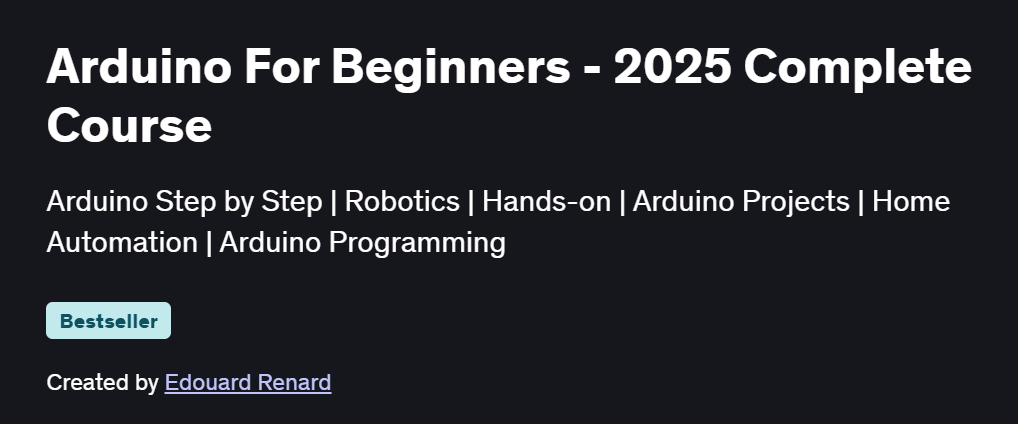Arduino For Beginners – 2025 Complete Course
An engaging, project-driven Arduino masterclass that equips newcomers with the coding and hardware skills to create real-world electronics and IoT applications.
What will you in Arduino For Beginners – 2025 Complete Course
Set up the Arduino IDE and proper wiring for your first projects
Write and upload sketches to control LEDs, buttons, and sensors
Use analog and digital I/O to read sensors and drive actuators
Interface with modules: LCDs, servos, motors, and communication peripherals
Design and build complete Arduino-based projects, from prototyping to PCB basics
Program Overview
Introduction & Setup
⏳ 30 minutes
Installing the Arduino IDE, configuring board and port settings
Breadboard basics: wiring power rails, grounding, and jumper connections
Blinking LED & Digital I/O
⏳ 45 minutes
Writing your first sketch:
pinMode(),digitalWrite(),delay()Reading button inputs with
digitalRead()and debouncing strategies
Analog Inputs & Outputs
⏳ 1 hour
Using
analogRead()to measure potentiometers and light sensorsGenerating PWM signals with
analogWrite()for dimming and speed control
Sensors & Actuators
⏳ 1 hour
Interfacing temperature, ultrasonic distance, and IR sensors
Driving servos, DC motors, and stepper motors with driver modules
Serial Communication & Displays
⏳ 45 minutes
Using
Serial.begin(),Serial.print(), and reading serial dataDriving character LCDs and OLED displays via I2C and SPI
Advanced Modules & Wireless
⏳ 1 hour
Working with RFID, Bluetooth (HC-05), and Wi-Fi (ESP8266) modules
Reading/writing data and remote control via smartphone apps
Powering & PCB Prototyping
⏳ 30 minutes
Power supply options: USB, batteries, and regulators
Transferring breadboard designs to perfboards and simple PCBs
Capstone Project: Smart Device Prototype
⏳ 1 hour
Designing, coding, and assembling an integrated project (e.g., environmental monitor)
Debugging tips and next-step ideas for scaling up
Get certificate
Job Outlook
- Arduino skills are prized in IoT development, prototyping labs, and maker spaces
- Applicable roles include Embedded Systems Engineer, IoT Developer, and Hardware Prototype Technician
- Opens opportunities in robotics, home automation, and wearable electronics
- Provides a foundation for careers in electronics design, firmware development, and STEM education
Explore More Learning Paths
Build on your Arduino foundation with courses that help you deepen your hardware skills, strengthen your programming logic, and move from beginner projects to more advanced, real-world electronics applications.
Related Courses
1. Interfacing with the Arduino Course
Learn how to connect sensors, actuators, and external components to build more complex and interactive Arduino systems.
2. The Arduino Platform and C Programming Course
Strengthen your understanding of the Arduino ecosystem while mastering essential C programming concepts used in microcontroller development.
3. Arduino Step by Step: Getting Started Course
A practical beginner-friendly guide to essential Arduino skills, covering hands-on projects, wiring basics, and hardware troubleshooting.
Related Reading
What Is Program Management?
A helpful overview of how complex projects are planned and executed—useful when you begin managing multi-component Arduino or IoT builds.
- Balanced mix of theory, coding, and hardware exercises
- Covers both classic Arduino boards and wireless modules
- Capstone project ties together all skills learned
- Limited depth on advanced PCB design and SMD assembly
- No live troubleshooting sessions or community-driven labs
Specification: Arduino For Beginners – 2025 Complete Course
|
FAQs
- No prior experience required; suitable for beginners.
- Learn Arduino IDE setup, breadboard wiring, and basic circuits.
- Covers coding fundamentals using sketches,
digitalWrite(),analogRead(), and more. - Introduces LEDs, buttons, sensors, and actuators step by step.
- Provides a solid foundation for further electronics and IoT learning.
- Control LEDs, buttons, and simple digital circuits.
- Interface with sensors like temperature, ultrasonic, and IR.
- Drive motors, servos, and stepper motors using Arduino.
- Work with LCDs, OLED displays, and I2C/SPI communication.
- Complete a capstone smart device project demonstrating all learned skills.
- Learn to connect Arduino with Bluetooth and Wi-Fi modules.
- Send and receive data for remote monitoring and control.
- Explore IoT project ideas for smart home or environmental monitoring.
- Understand the basics of wireless communication protocols.
- Gain hands-on experience integrating hardware and software for IoT solutions.
- Access via desktop, laptop, or tablet with internet.
- Arduino board, breadboard, jumper wires, LEDs, resistors, and sensors.
- Optional modules: LCDs, motors, Bluetooth, and Wi-Fi boards.
- Visual guides, exercises, and capstone projects included.
- Self-paced modules allow learning anytime, anywhere.
- Prepares for roles like Embedded Systems Engineer, IoT Developer, or Hardware Prototype Technician.
- Provides hands-on experience for prototyping and small-scale electronics projects.
- Builds foundation for careers in robotics, home automation, and wearable tech.
- Supports further learning in PCB design, advanced coding, and IoT applications.
- Certificate validates technical competency for professional growth.





